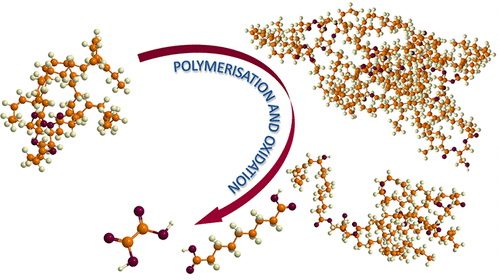当前位置:
X-MOL 学术
›
Acc. Chem. Res.
›
论文详情
Our official English website, www.x-mol.net, welcomes your
feedback! (Note: you will need to create a separate account there.)
Conservation Issues of Modern Oil Paintings: A Molecular Model on Paint Curing.
Accounts of Chemical Research ( IF 16.4 ) Pub Date : 2019-11-19 , DOI: 10.1021/acs.accounts.9b00296 Ilaria Bonaduce 1 , Celia Duce 1 , Anna Lluveras-Tenorio 1 , Judith Lee 2 , Bronwyn Ormsby 2 , Aviva Burnstock 3 , Klaas Jan van den Berg 4
Accounts of Chemical Research ( IF 16.4 ) Pub Date : 2019-11-19 , DOI: 10.1021/acs.accounts.9b00296 Ilaria Bonaduce 1 , Celia Duce 1 , Anna Lluveras-Tenorio 1 , Judith Lee 2 , Bronwyn Ormsby 2 , Aviva Burnstock 3 , Klaas Jan van den Berg 4
Affiliation

|
The 20th and 21st century oil paintings are presenting a range of challenging conservation problems that can be distinctly different from those noted in paintings from previous centuries. These include the formation of vulnerable surface "skins" of medium and exudates on paint surfaces, efflorescence, unpredictable water and solvent sensitivity, and incidence of paint dripping which can occur within a few years after the paintings were completed. Physicochemical studies of modern oil paints and paintings in recent years have identified a range of possible causal factors for the noted sensitivity of painting surfaces to water and protic solvents, including the formation of water-soluble inorganic salts and/or the accumulation of diacids at the paint surface, which are oxidation products of the oil binder. Other studies have investigated the relationship between water sensitivity and the degree of hydrolysis of the binder, the proportions of free fatty and dicarboxylic acids formed, as well as the relative content of free metal soaps. Thus far, data indicate that the qualitative and quantitative composition of the nonpolymerized fractions of the oil binder cannot be solely or directly related to the solvent sensitivity of the paint film. Conclusions therefore indicate that the polymeric network, formed upon the curing of the oil, plays a fundamental role, suggesting that water sensitivity, at least in some cases, may be related to the poor development and/or polar nature of the formed polymeric network rather than the composition of the nonpolymerized fractions. Poorly developed polymeric networks, in combination with the migration of polar fractions, i.e., dicarboxylic and hydroxylated fatty acids toward the paint surface, can be related to other degradation phenomena, including the separation and migration of the paint binder which can lead to the presence of observable skins of medium as well as the more alarming phenomenon of liquefying or dripping oil paints. It is thus crucial to understand the molecular composition of these paints and their physicochemical behavior to aid the further development of appropriate conservation and preservation strategies, as the risks currently associated with surface cleaning treatments and other conservation procedures can be unacceptably high. This Account reviews the relationships between the degradation phenomena associated with modern oil paintings and the chemical composition of the oil binder and proposes a molecular model for the development of water sensitivity and other noted degradation phenomena. It is suggested that water sensitivity (and possibly other degradation phenomena) is a consequence of processes that take place upon curing, and in particular to the rate of formation and decomposition of alkoxyl and peroxyl radicals. These reactions are strongly dependent on the type of oil present, the ambient environmental conditions, and the chemical and physical nature of the pigments and additives present in the paint formulation. When the curing environment is oxidizing, the chemistry of peroxyl radicals dominates the reaction pathways, and oxidative decomposition of the paint film overwhelms cross-linking reactions.
中文翻译:

现代油画的保护问题:油漆固化的分子模型。
20世纪和21世纪的油画提出了一系列具有挑战性的保护问题,这些问题可能与以前几个世纪的油画有明显的不同。这些包括油漆表面上介质和渗出液的脆弱表面“皮肤”的形成,起花,不可预测的水和溶剂敏感性以及油漆滴落的发生率,这些现象可能在油漆完成后的几年内发生。近年来对现代油漆和绘画的物理化学研究已经确定了一系列可能的因果关系,这些因素可引起绘画表面对水和质子溶剂的显着敏感性,包括水溶性无机盐的形成和/或二酸在表面上的积累。油漆表面,是油性粘合剂的氧化产物。其他研究已经研究了水敏感性与粘合剂的水解度,形成的游离脂肪和二羧酸的比例以及游离金属皂的相对含量之间的关系。迄今为止,数据表明油性粘合剂的未聚合部分的定性和定量组成不能单独或直接与漆膜的溶剂敏感性有关。因此,结论表明,在油的固化过程中形成的聚合物网络起着基本作用,这表明至少在某些情况下,水敏感性可能与所形成的聚合物网络的不良显影和/或极性有关。比未聚合馏分的组成。聚合物网络发展不佳,与极性组分(即二羧酸和羟基化脂肪酸)向油漆表面的迁移结合,可能与其他降解现象有关,包括油漆粘合剂的分离和迁移,这可能导致可观察到的介质表皮的存在。以及液化或滴落油漆的更令人震惊的现象。因此,至关重要的是要了解这些涂料的分子组成及其理化特性,以帮助进一步发展适当的防腐和防腐策略,因为目前与表面清洁处理和其他防腐程序有关的风险可能会很高。该报告回顾了与现代油画相关的降解现象与油性粘合剂的化学成分之间的关系,并提出了用于开发水敏性和其他显着降解现象的分子模型。建议水敏感性(以及可能的其他降解现象)是固化时发生的过程的结果,特别是烷氧基和过氧基的形成和分解的速率的结果。这些反应在很大程度上取决于油的类型,周围环境条件以及涂料配方中存在的颜料和添加剂的化学和物理性质。当固化环境被氧化时,过氧自由基的化学反应将主导反应路径,
更新日期:2019-11-20
中文翻译:

现代油画的保护问题:油漆固化的分子模型。
20世纪和21世纪的油画提出了一系列具有挑战性的保护问题,这些问题可能与以前几个世纪的油画有明显的不同。这些包括油漆表面上介质和渗出液的脆弱表面“皮肤”的形成,起花,不可预测的水和溶剂敏感性以及油漆滴落的发生率,这些现象可能在油漆完成后的几年内发生。近年来对现代油漆和绘画的物理化学研究已经确定了一系列可能的因果关系,这些因素可引起绘画表面对水和质子溶剂的显着敏感性,包括水溶性无机盐的形成和/或二酸在表面上的积累。油漆表面,是油性粘合剂的氧化产物。其他研究已经研究了水敏感性与粘合剂的水解度,形成的游离脂肪和二羧酸的比例以及游离金属皂的相对含量之间的关系。迄今为止,数据表明油性粘合剂的未聚合部分的定性和定量组成不能单独或直接与漆膜的溶剂敏感性有关。因此,结论表明,在油的固化过程中形成的聚合物网络起着基本作用,这表明至少在某些情况下,水敏感性可能与所形成的聚合物网络的不良显影和/或极性有关。比未聚合馏分的组成。聚合物网络发展不佳,与极性组分(即二羧酸和羟基化脂肪酸)向油漆表面的迁移结合,可能与其他降解现象有关,包括油漆粘合剂的分离和迁移,这可能导致可观察到的介质表皮的存在。以及液化或滴落油漆的更令人震惊的现象。因此,至关重要的是要了解这些涂料的分子组成及其理化特性,以帮助进一步发展适当的防腐和防腐策略,因为目前与表面清洁处理和其他防腐程序有关的风险可能会很高。该报告回顾了与现代油画相关的降解现象与油性粘合剂的化学成分之间的关系,并提出了用于开发水敏性和其他显着降解现象的分子模型。建议水敏感性(以及可能的其他降解现象)是固化时发生的过程的结果,特别是烷氧基和过氧基的形成和分解的速率的结果。这些反应在很大程度上取决于油的类型,周围环境条件以及涂料配方中存在的颜料和添加剂的化学和物理性质。当固化环境被氧化时,过氧自由基的化学反应将主导反应路径,

































 京公网安备 11010802027423号
京公网安备 11010802027423号